OS X Mavericks
Upgrading to OS X Mavericks
Upgrading to OS X Mavericks
Since Mavericks is no longer the most recent version of OS X, it is not currently available for purchase. Some of the information in this lesson is only applicable if you already have a copy of Mavericks. However, OS X Yosemite is available as a free upgrade. For more information, check out our OS X Yosemite tutorial.
If you're thinking about upgrading to Mavericks, you'll need to make sure your computer meets all of the software and hardware requirements. Here are the things you'll need to have:
- Apple Macintosh Computer (Mac): Generally, you'll need to have a Mac in order to install OS X Mavericks. Installing Mavericks on a PC is possible, but it requires more advanced techniques.
- OS X Snow Leopard, Lion, or Mountain Lion: If you are using an older version of OS X such as Leopard, you will need to upgrade to Snow Leopard (version 10.6.8), Lion, or Mountain Lion before upgrading to Mavericks.
- Internet access: To install Mavericks, you will need to download it from the Mac App Store, which requires a working Internet connection. Mavericks is not available on CD or DVD.
- Apple ID: Your Apple ID is used to sign in to the Mac App Store, iTunes Store, and more. It's OK if you don't have an Apple ID yet—you'll be able to create one when you download Mavericks.
- Hardware requirements: Your Mac will need to meet certain processor, memory, and hard drive requirements to install Mavericks. Below are the models that can be upgraded:
- iMac (mid-2007 or newer)
- MacBook (late 2008 Aluminum or early 2009 or newer)
- MacBook Pro (mid/late 2007 or newer)
- MacBook Air (late 2008 or newer)
- Mac mini (early 2009 or newer)
- Mac Pro (early 2008 or newer)
- Xserve (early 2009)
For a full list of hardware requirements, view the OS X Mavericks Technical Specifications.
Viewing information about your Mac
To upgrade to Mavericks, you'll need to know what kind of hardware your Mac has, as well as which version of OS X you are using. Then you can compare it with the requirements above to decide whether you'll be able to upgrade. On a Mac, all of your system information is visible from the About This Mac window.
- Click the Apple icon in the top-left corner of the screen, then select About This Mac.
 Selecting About This Mac
Selecting About This Mac - A window will appear that shows information about your hardware and software.
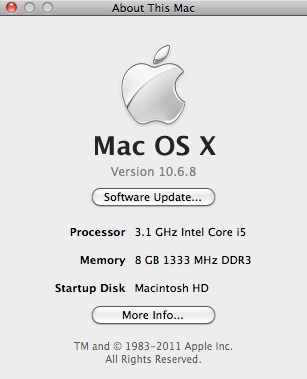 Viewing hardware and software info
Viewing hardware and software info
Software compatibility
In order for software to work, it has to be compatible with the operating system. Therefore, you may not be able to use all of your existing software if you switch to a different operating system. Before you switch, ask yourself if there is any software that you can't do without. Then do some research to find out if it is compatible with Mavericks.
Upgrading from earlier versions of OS X
If you are upgrading from an earlier version of OS X, most of your apps should still work. However, it's possible that some might not. A simple Google search will often be enough to tell if an app will be compatible in Mavericks.
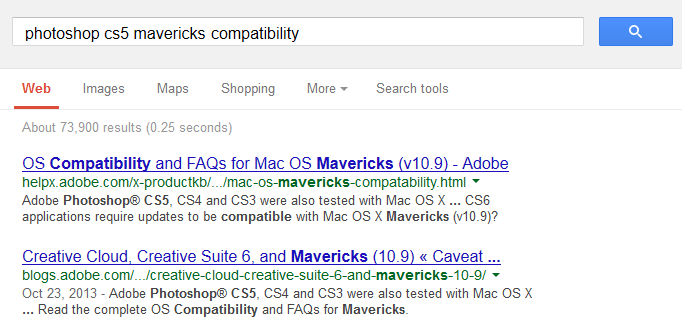 Searching the web for compatibility info
Searching the web for compatibility infoSwitching from Windows to OS X
Some PC software will not work in OS X, but there may be a Mac version that you can buy or download. For example, Microsoft Office 2010 does not run in OS X, but you can buy Microsoft Office for Mac to view and edit your documents. However, not all software has a Mac version, and you may need to do some research to find out if there are Mac versions for your most important programs.
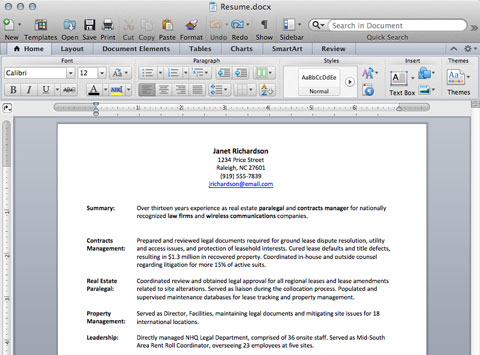 Microsoft Word for Mac
Microsoft Word for MacInstalling Windows on a Mac
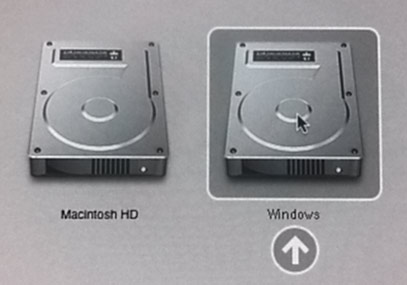 Running Windows with Boot Camp
Running Windows with Boot CampIf you absolutely need to use PC software and there isn't a Mac version, you can use a feature called Boot Camp. Boot Camp comes pre-installed in OS X, and it allows you to install Windows on your Mac (if you have the Windows installation discs). You can then install any PC software you need.
The main disadvantage of Boot Camp is that you have to restart your computer whenever you want to switch between OS X and Windows. If you need to run PC and Mac software at the same time, you will need to buy additional software such as Parallels or VMware.
Moving your files from another computer
Mavericks makes it easy to transfer all of your files to your new Mac using the built-in Migration Assistant. It lets you choose which folders and accounts you want to copy, and then it can transfer the files using an external hard drive, an existing home network, a FireWire cable, or an Ethernet cable. Migration Assistant can also transfer files from a PC to your new Mac.
If you are using a brand new Mac, the Migration Assistant will appear when you first turn on the computer. If you would prefer to run it later, you can get to it by opening Launchpad and clicking the Utilities folder. Alternatively, you can search for it with Spotlight by clicking the magnifying glass icon in the top-right corner of the screen.
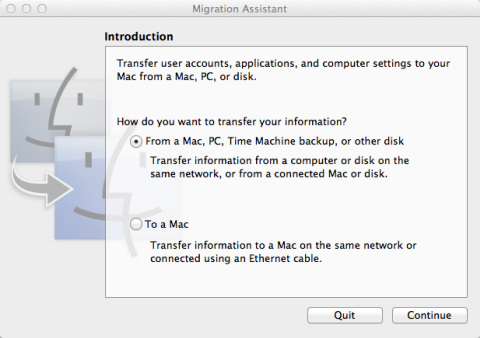 The Migration Assistant
The Migration AssistantFor full instructions on migrating your files, view the Migration Assistant page on the Apple website.


